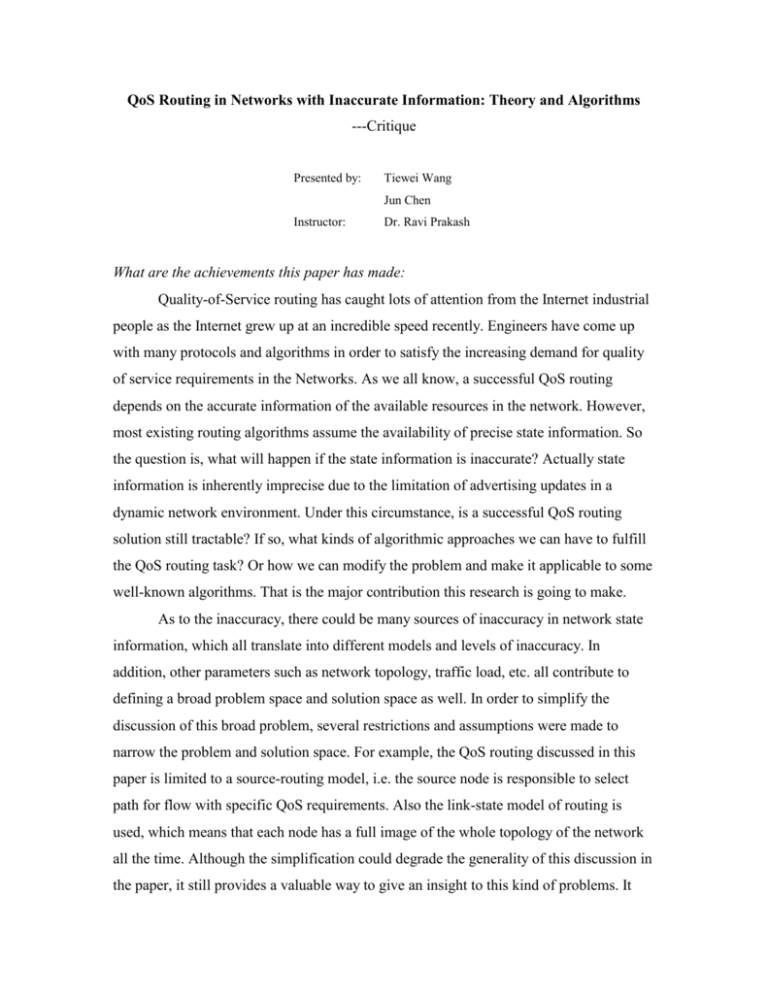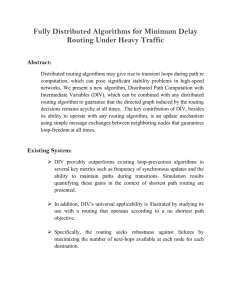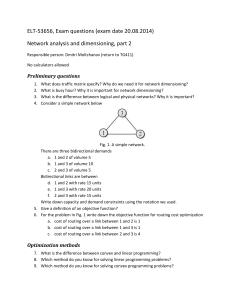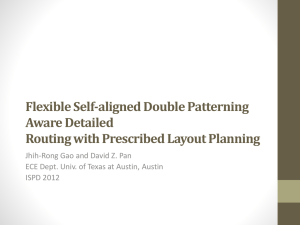QoS Routing in Networks with Inaccurate Information: Theory and
advertisement

QoS Routing in Networks with Inaccurate Information: Theory and Algorithms ---Critique Presented by: Tiewei Wang Jun Chen Instructor: Dr. Ravi Prakash What are the achievements this paper has made: Quality-of-Service routing has caught lots of attention from the Internet industrial people as the Internet grew up at an incredible speed recently. Engineers have come up with many protocols and algorithms in order to satisfy the increasing demand for quality of service requirements in the Networks. As we all know, a successful QoS routing depends on the accurate information of the available resources in the network. However, most existing routing algorithms assume the availability of precise state information. So the question is, what will happen if the state information is inaccurate? Actually state information is inherently imprecise due to the limitation of advertising updates in a dynamic network environment. Under this circumstance, is a successful QoS routing solution still tractable? If so, what kinds of algorithmic approaches we can have to fulfill the QoS routing task? Or how we can modify the problem and make it applicable to some well-known algorithms. That is the major contribution this research is going to make. As to the inaccuracy, there could be many sources of inaccuracy in network state information, which all translate into different models and levels of inaccuracy. In addition, other parameters such as network topology, traffic load, etc. all contribute to defining a broad problem space and solution space as well. In order to simplify the discussion of this broad problem, several restrictions and assumptions were made to narrow the problem and solution space. For example, the QoS routing discussed in this paper is limited to a source-routing model, i.e. the source node is responsible to select path for flow with specific QoS requirements. Also the link-state model of routing is used, which means that each node has a full image of the whole topology of the network all the time. Although the simplification could degrade the generality of this discussion in the paper, it still provides a valuable way to give an insight to this kind of problems. It truly addresses the problem of evaluating the fundamental impact of inaccuracy in state information. The most valuable contribution of this paper made is that it used a systematic way to investigate the QoS routing problem. Formal specification of the problem, the derivation of basic complexity results, and the investigation and validation of a representative sample of algorithmic approaches, the whole set of solution show us a practical way to deal with this kind of problem. Based on the usage of probability distribution functions, this paper discussed in details about how to solve the QoS routing with bandwidth and end-to-end delay requirements under the presence of certain inaccuracy of state information. For QoS routing with bandwidth requirement, this paper showed that it could be easily solved by applying the most reliable path algorithm (MRP). For QoS routings with end-to-end delay requirement, this paper applied two models, namely, the rate-based model and delaybased model. The reason to address these two models separately is that it is proved that solution for the additive delay-based model will be more complicated than the rate-based model. Although they are proved to be NP-complete problem, this paper shows how the problem can be transferred into a tractable problem by restricting the probability distribution functions. For the rate-based model, four special cases are identified, namely, deterministic rate case, identical dl(link propagation delay)’s, identical PDF’s, and exponential distributions. In the real world, these special cases could be true in some part of networks. Also, an -optimal solution is presented, which is valuable for actual implementation. For the delay guarantee model, two special cases are identified, namely, identical PDF’s and tight constraints. Besides, this paper also provides two heuristic algorithms that split the global delay constraints into local constraints, which applies well to the state inaccuracy caused by state aggregation. Many algorithms would be very valuable when used for handling the inaccuracy in the real world implementation. It is believed that there will be more researches to be presented concerning QoS routing with inaccurate information. This paper undoubtedly did some valuable and practical pioneer works in this field. 2 Weak points and further investigation: QoS routing with inaccurate state information is very broad problem. So this single paper can only shed a light into a very small part of the whole problem space. Due to the simplification of the original problem, there are many issues and aspects not discussed in this paper, which limits the practical value of this paper. As the authors admitted in the paper, other criteria like optimization of network utilization, carried load, and number of flows successfully routed etc. have not been considered when dealing the QoS routing with the presence of inaccurate information. In the final section of the paper, it only briefly noted a possible approach for incorporating such criteria into their model, which is to appropriately “distort” the pdf’s used to account for state inaccuracy. For example, if network optimization requires discouraging the use of a link, its related pdf can be (artificially) changed so as to manifest lower success probabilities. However, necessary details were not addressed in this paper, and a further investigation is really needed for the real implementation of this approach. There are several routing strategies currently used for QoS routing. This paper assumed the source routing as the routing strategy. However, source routing has a scalability problem since the computation overhead at the source is excessively high. It is impractical for any single node that has access to detailed state information about all nodes and all links in a large network. So a source routing strategy has limited usage in large-scale networks. This paper does not discuss other important routing strategies like distributed routing, based on which the path is computed by a distributed computation. Control messages are exchanged among the nodes, and the state information kept at each node is collectively used for the path search. Most distributed routing algorithms need a distance-vector protocol (or a link-state protocol) to maintain a global state in the form of distance vectors at every node. Based on the distance vectors, the routing is done on a hop-by-hop basis. To be sure, solutions for a distributed QoS routing with inaccurate information will be much more difficult, which is also a valuable issue for discussion. Besides, this paper implicitly incorporated the third routing strategy --- hierarchical routing when it discussed the heuristic algorithms for hierarchical networks environment. 3 In our opinion, it will be better to specifically discuss the QoS routing by using hierarchical routing with inaccurate information. Another issue need to be addressed is multicast routing. All the routing problems discussed in this paper can be classified into the unicast routing problem. An unicast routing can be defined as follows: given a source node s, a destination node t, a set of QoS constraints C, and possibly an optimization goal, find the best feasible path from s to t which satisfies C. However, it did not talk about multicast QoS routing. A multicast routing can be defined as follows: given a source node s, a set R of destination nodes, a set of constraints C and possibly an optimization goal, find the best feasible tree covering s and all nodes in R which satisfies C. Multicast routings are very important for recent new Internet applications such as video conferencing etc. With the presence of inaccurate information, a multicast routing surely will be different from unicast routing. The calculation of probability over a multicast tree will be more complicated than that over a single path, which is also a very valuable field to explore. Another aspect concerning the problem discussed in this paper is identifying probability distribution that can realistically capture the inaccuracy in state information. The exponential distribution is considered as an attractive candidate because it is an intuitively reasonable model, and on which also yields practical solutions. However, in our points of view, individual probability distribution model combined with each network update mechanisms will be a more practical approach. An efficient and correct way of calculating the probability distribution function is essential for the successful implementation of all the models discussed in this paper. A further investigation is surely important and valuable. For the purpose of simplification, this paper separate the investigation of QoS routing by dividing the QoS requirements into two fundamental parts, namely bandwidth requirement and end-to-end delay requirement. In a real-world implementation, these requirements will be combined together to constitute a set of QoS requirement, A simple division of these QoS requirements is surely not sufficient. This is also one of the issue, we think, should be address in later researches. 4 Simplification makes problem easier to understand and solve. However, this must be done very careful. Too simplification will lost its academic or practical values. Some assumptions such as the exponential distribution of probability in the discussion of this paper are doubtful due to their rare presence in the real world. In some cases, the time complexity after the simplification is still not optimistic for real implementation in largescale networks. For example, with identical propagation link delay distribution dl for the end-to-end delay requirements, the time complexity is O(N2M), which is still expensive for large scale networks. In no doubt, the topic discussed in this paper is very important since the dynamic inter-network is growing more complicated. However, the models presented in this paper are mainly academically valuable. In order to apply the theory and algorithms into the real implementation of QoS routing, a lot of more detailed investigations still have to been done. 5








